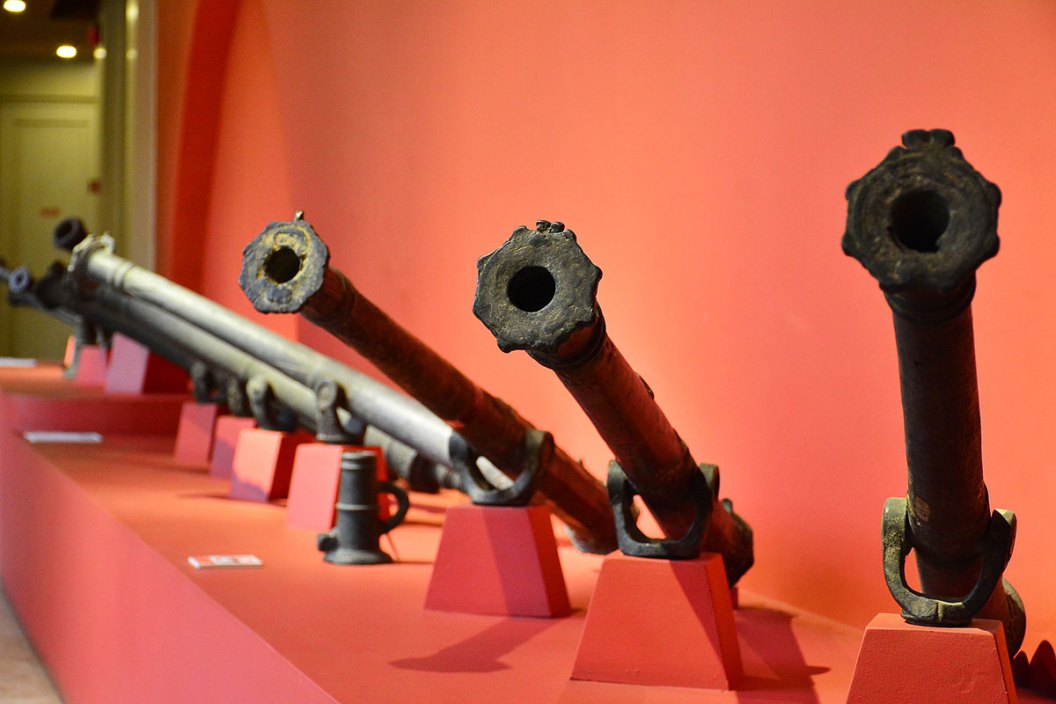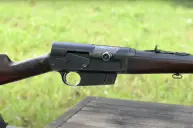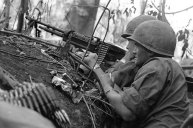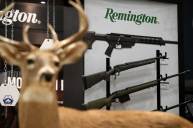The history of firearms is a longer one than many might think.
To invent the first gun, it is necessary to invent gun powder of some kind. That's the tricky part. The rest is just a projectile, a metal tube to contain and direct the fire, and a method for igniting the charge. Yet gunpowder is fairly ancient.
The origins of the earliest gunpowder are not known, and arguments say it may have first been invented in China, Turkey, or Europe. An early written description of combining charcoal, sulphur, and saltpeter to produce gunpowder dates to 1250 in Europe.
However, there is evidence that gunpowder was used in China as early as the 9th century and that around 1000 A.D., a bamboo tube using gunpowder to fire a spear was used in China. Technically, that could be called the first firearm.
In 1132, an account of the siege of De'an says that Song forces used "fire-lances," likely black-powder filled tubes that were attached to a spear and used as primitive flamethrowers, with shrapnel sometimes added to the tube.
Over time, the portion of saltpeter in the gunpowder mix was increased to make it more explosive. The greater power required metal tubes and to take full advantage of that power, projectiles that were more closely sized to the barrel were developed.
So, by the early 1300s, the basic elements of what we would call a firearm were produced as primitive cannons with barrels made of metal, gunpowder with a high nitrate content, and a projectile that totally fills the muzzle diameter.
Gun Design Progresses
In 1336, the Majapahit Empire began using a breech-loading gun called the cetbang during its conquest of Nusantara. They were swivel guns mounted on naval vessels used in boarding warfare.
It is posited that gunpowder arrived in Europe via the Silk Road through the Middle East, or that it was brought during the Mongol Invasion in the early 13th century. A type of cannon was written about in the 1340s and siege guns were used by the English at Calais in 1346.
The oldest surviving firearm in Europe was found in Estonia and dates to at least 1396.
In the late 14th century, smaller, portable hand cannons were developed in Europe and became the first personal smooth-bore firearms. By the early 15th century, such arms were used in the regular infantry of the Ottoman Empire.
The First Trigger-Fired Guns
In the early 15th century, the matchlock also appeared. Before then, handheld firearms were fired by holding a burning wick to a touch hole. Basically they were just miniaturized cannons.
This required a shooter to use a prop to steady the gun barrel, as it took both hands to fire it. The matchlock was the first gun that performed this task with the pull of a trigger.
Powder to ignite the main charge was held in an open flash pan, and the matchlock mechanism held a burning wick in a movable, spring-loaded clamp. When the trigger was pulled, the clamp rotated and touched the wick to the pan, igniting it. For a good example of how this worked, check out the movie,"The Witch" from 2015.
In the following years, the British and then the United States would dominate firearm production, along with Italian, German, and Belgian gun companies, along with many others.
The matchlock was replaced with the wheel-lock, which was, in turn, replaced by the flintlock, which ignited the powder in a closed flash pan. The ignition system used a knapped piece of flint held in a clamp and struck against a frisson to create a shower of sparks.
The fairly reliable and simple flintlock design was used for many years around the same time that rifling was found to make projectiles fly farther and truer. Smoothbore muskets gave way to rifles, then, percussion caps replaced the flint and frisson as a much more reliable and more weatherproof way of igniting the gunpowder in the barrel.
By the 19th century, soldiers typically kept pre-measured charges of blackpowder in paper packets, or the blackpowder was rolled into a paper cartridges with the bullet included and the whole thing waxed, ready to be loaded into gun barrels.
Breech Loading Rifles and Machine Guns
The first successful breech loading rifle, the Sharps, used paper cartridges when it was first introduced in the mid 19th century.
Percussion caps also made the earliest revolver handguns possible, with the most successful developed by famed gunsmith Samuel Colt with the Colt Walker and later Colt Dragoon models. While these single action handguns offered six shots in fairly rapid succession, reloading them was a slow process.
The first machine gun came during the American Civil War when the Gatling Gun, developed by Richard Gatling, was introduced in 1861 along with the advent of the earliest metallic cartridges.
Repeating Rifles
The first successful repeating rifle was the Spencer carbine, which was introduced in 1860 and used metallic cartridges loaded into a magazine tube in the buttstock.
Later the Henry Rifle and then the Winchester 1873 would make repeaters the do-it-all rifles for hunters, frontiersmen, and soldiers as well until the development of spitzer-shaped bullets and bolt action rifles.
Guns of the World Wars
By the time World War I and the 20th century arrived, smokeless powder replaced blackpowder and fully automatic machine guns had been around for a couple decades, giving them more than enough time to be battlefield ready.
Though they were still cumbersome and required multiple people to operate, they were devastating on the battlefield, and largely contributed to the stagnant entrenched fronts of the war.
By World War II, machine gun design had come a long way, and some guns from the era, like the Browning M2 .50-Caliber machine gun, are still used today. The British modified the first machine gun, the Maxim Gun, into the Lewis gun, which began service in World War I and was used until 1968.
While many forces used bolt action rifles in both world wars, in WWII, the U.S. military adopted its first semi-automatic service rife, the M1 Garand, which replaced the Springfield Model 1903 bolt action rifle used in WWI.
The U.S. also adopted a semi-automatic pistol as its general issues sidearm in the M1911A1, with revolvers relegated to a supporting role. Fully automatic submachine guns were used by nearly all forces in WWII for a variety of applications.
To gear up on shooting supplies, go to Cabelas.com.
NEXT: 10 IDEAL HOME DEFENSE HANDGUNS
WATCH





